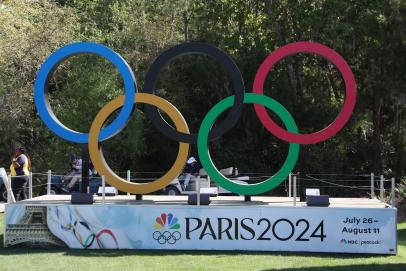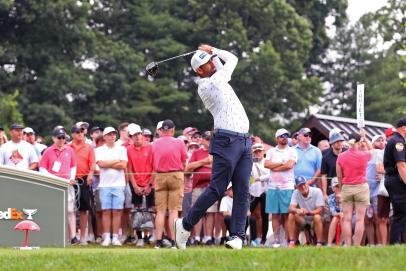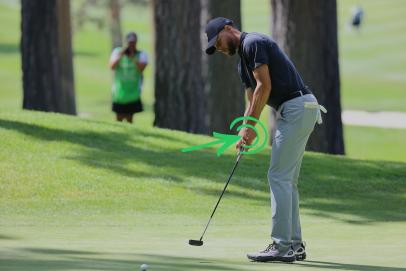SAINT-QUENTIN-EN-YVELINES, France — They don’t hand out medals at the Sony Open, Valspar Championship or even the Myrtle Beach Classic. But all of those had higher first-round scoring averages than Thursday’s first round of the Olympics.
Le Golf National, often one of the tougher tracks on the DP World Tour, was relatively defenseless against the best Olympic men’s golf field ever. An already softened course from weekend rains (you’ll remember the downpours of the Olympics’ Opening Ceremony) got some extra cushioning from an early morning downpour that added a half-inch of rain to the mix. The result was a first-round scoring average of 69.82 and a field that was a combined 86-under par. Half the holes played under par for the day, and the field averaged four birdies per round.
The challenge of the target-style golf course is when it plays faster and firmer. When it’s soft and the best players in the world are hitting their targets, it’s just a matter of rolling putts. And the greens at Le Golf National have been praised all week. None did it better than leader Hideki Matsuyama. The 12th-ranked player in the world with 18 career worldwide wins, Matsuyama hit 11 fairways and 16 greens on his way to an eight-under 63.
His round was typical of the leaders. The top-five finishers on the board averaged 11 fairways hit and 12 greens in regulation. You don’t scramble your way around Le Golf National, Jon Rahm said prior to the tournament, noting “I think you're going to see all of us hitting it to the same spots off the tee and playing it very, very similarly.”
Even so, a player like Ludvig Åberg, who missed more than half the fairways still managed five birdies on his three-under round. Soft greens made the penalty of the rough less severe than tournament organizers had hoped.
“When the wind is down and the greens are relatively receptive, yes, there's always going to be good scores,” he said. “But it's a great golf course because you still have to hit the shot, and if you don't hit the shot, you're going to be punished.”
That’s exactly how things proceeded on Thursday. Of the 116 birdies recorded on the 11 par 4s, only six came on approach shots from the rough. Typical were the shorter par 4s like Nos. 1, 10 and 13, where only one of the 37 birdies came from an approach shot from the rough.
Of course, the case also can be made that at 7,174 yards, Le Golf National isn’t the beast it once was. For example, six of the last seven winners of the French Open have posted double-digits under par. Three of the years prior to that, the 72-hole winning score was equal or worse than Matsuyama’s round. Indeed, if you compare the scoring average on Thursday to the easiest of the four majors, the PGA Championship, Valhalla’s first round played 1.4 shots harder.
Let’s also remember that unlike any other tournament, only the top three positions matter. It’s a race to the medal stand and only the bold will survive, said Sami Välimäki, who finished at four-under 67 after bogeying the last two holes after missed fairways. “It's the soft greens and they are rolling nice,” he said. “A lot of players can make a lot of putts, and if they hit the fairways, you don't have two long clubs into the greens, so you can be aggressive on the approach shots.
“You just need to hit the ball well. That's the only thing over there. If you start missing off the tee, it's going to be tough.”
Still, there doesn’t appear to be any rain in the forecast. Le Golf National, with three of its last four holes featuring water and the bunkerless par-4 17th playing over par, expect Le Golf National to bite back. Alex Noren, who won at Le Golf National in 2018 with a score of seven under for the week, said after his four-under round that the course is playing as easy as he’s ever seen it. But wait.
“I just think there are enough guys that are good, so the scores are low but I don't think it's easy,” he said. “If you hit a good shot, you're going to get it close. Some courses we play when it's firm, you hit a good shot and it's 25 feet, 30 feet. Here, if you actually hit a 5-iron straight at the pin, it will stop. So the softness of the greens after the rain helps tremendously.
“But I think everybody is underestimating the toughness of the actual course. So if you start seeing more wind, more firmness, it's a totally different course.”
More From Golf Digest
 Olympics
Increasing golf's presence in the Olympics on the agenda for 2028 and beyond
Olympics
Increasing golf's presence in the Olympics on the agenda for 2028 and beyond
 Branded Content
Better Decisions and Signature Stories: Recapping Year One of the Aon Next 10 and Aon Swing 5
Branded Content
Better Decisions and Signature Stories: Recapping Year One of the Aon Next 10 and Aon Swing 5
 Instruction
Steph Curry's putting stroke features a useful tip for the rest of us
Instruction
Steph Curry's putting stroke features a useful tip for the rest of us